美国南北战争英文介绍
- 格式:pptx
- 大小:7.67 MB
- 文档页数:3
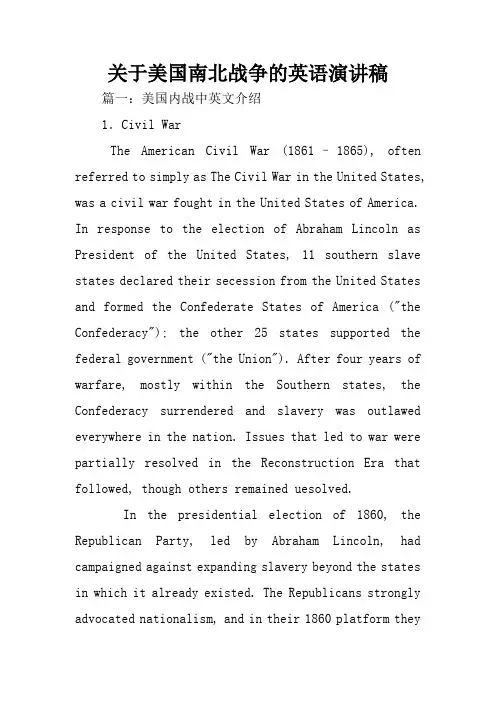
关于美国南北战争的英语演讲稿篇一:美国内战中英文介绍1.Civil WarThe American Civil War (1861–1865), often referred to simply as The Civil War in the United States, was a civil war fought in the United States of America. In response to the election of Abraham Lincoln as President of the United States, 11 southern slave states declared their secession from the United States and formed the Confederate States of America ("the Confederacy"); the other 25 states supported the federal government ("the Union"). After four years of warfare, mostly within the Southern states, the Confederacy surrendered and slavery was outlawed everywhere in the nation. Issues that led to war were partially resolved in the Reconstruction Era that followed, though others remained uesolved.In the presidential election of 1860, the Republican Party, led by Abraham Lincoln, had campaigned against expanding slavery beyond the states in which it already existed. The Republicans strongly advocated nationalism, and in their 1860 platform theydenounced threats of disunion as avowals of treason. After a Republican victory, but before the new administration took office on March 4, 1861, seven cotton states declared their secession and joined to form the Confederate States of America. Both the outgoing administration of President James Buchanan and the incoming administration rejected the legality of secession, considering it rebellion. The other eight slave states rejected calls for secession at this point. No country in the world recognized the Confederacy.Hostilities began on April 12, 1861, when Confederate forces attacked a military installation at Fort Sumter in South Carolina. Lincoln responded by calling for a volunteer army from each state to recapture federal property, which led to declarations of secession by four more slave states. Both sides raised armies as the Union seized control of the border states early in the war and established a naval blockade. Land warfare in the East was inconclusive in 1861–62, as the Confederacy beat back Union efforts to capture its capital, Richmond, Virginia, notably during the Peninsular Campaign. In September 1862, theConfederate campaign in Maryland ended in defeat at the Battle of Antietam, which dissuaded the British from intervening.[2] Days after that battle, Lincoln issued the Emancipation Proclamation, which made ending slavery a war goal.[3]In 1863, Confederate general Robert E. Lee's northward advance ended in defeat at the Battle of Gettysburg. To the west, the Union gained control of the Mississippi River after the Battle of Shiloh and Siege of Vicksburg, splitting the Confederacy in two and destroying much of their western army. Due to his western successes, Ulysses S. Grant was given command of the eastern army in 1864, and organized the armies of William Tecumseh Sherman, Philip Sheridan and others to attack the Confederacy from all directions, increasing the North's advantage in manpower. Grant restructured the union army, and put other generals in command of divisions of the army that were to support his push into Virginia. He fought several battles of attrition against Leethrough the Overland Campaign to seize Richmond, though in the face of fierce resistance he altered hisplans and led the Siege of Petersburg which nearly finished off the rest of Lee's army. Meanwhile, Sherman captured Atlanta and marched to the sea, destroying Confederate infrastructure along the way. When the Confederate attempt to defend Petersburg failed, the Confederate army retreated but was pursued and defeated, which resulted in Lee's surrender to Grant at Appomattox Court House on April 9, 1865.The American Civil War was one of the earliest true industrial wars. Railroads, the telegraph, steamships, and mass-produced weapons were employed extensively. The practices of total war, developed by Sherman in Georgia, and of trench warfare around Petersburg foreshadowed World War I in Europe. It remains the deadliest war in American history, resulting in the deaths of 620,000 soldiers and an undetermined number of civilian casualties. Historian John Huddleston estimates the death toll at ten percent of all Northern males 20–45 years old, and 30 percent of all Southern white males aged 18–40.[4] Victory for the North meant the end of the Confederacy and of slavery in the United States, and strengthened the roleof the federal government. The social, political, economic and racial issues of the war decisively shaped the reconstruction era that lasted to 1877.美国南北战争(1861-1865),通常被称为在美国南北战争,是一场内战,战斗在美利坚合众国。


介绍一下美国内战英文作文英文:The American Civil War, which lasted from 1861 to 1865, was a major conflict between the Northern and Southern states of the United States. The war was fought over a number of issues, including slavery, states' rights, and economic differences between the North and South.One of the main causes of the Civil War was slavery. The South relied heavily on slave labor to work their plantations, while the North had already abolished slavery. The North believed that slavery was morally wrong and wanted to see it abolished throughout the country. The South, on the other hand, believed that they had the right to own slaves and that the federal government should not interfere with their way of life.Another issue that led to the Civil War was states' rights. The South believed that each state should have theright to decide whether or not to allow slavery, while the North believed that the federal government should have the power to regulate slavery.The economic differences between the North and South also played a role in the Civil War. The North was becoming more industrialized and relied on manufacturing, while the South was still primarily agricultural. The North wanted to impose tariffs on imported goods, which would have hurt the South's economy.The Civil War was a brutal conflict that resulted in the deaths of over 620,000 Americans. It also had a lasting impact on the country, as it led to the end of slavery and the reunification of the United States.中文:美国内战发生于1861年至1865年之间,是美国北部和南部州之间的一场重大冲突。

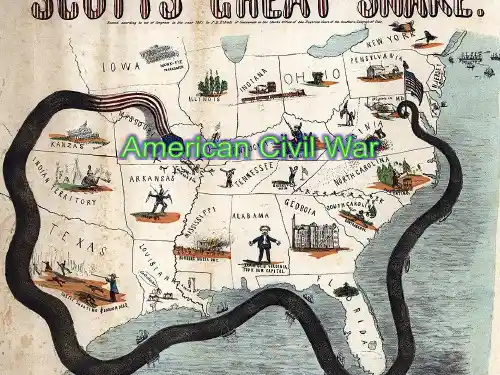


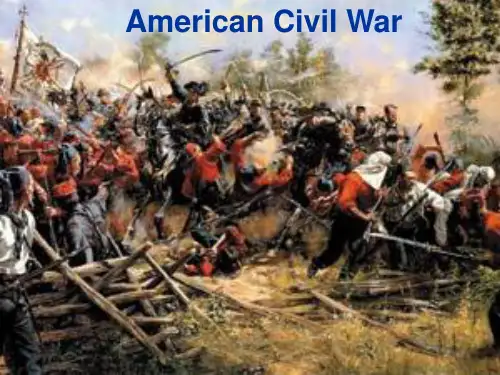
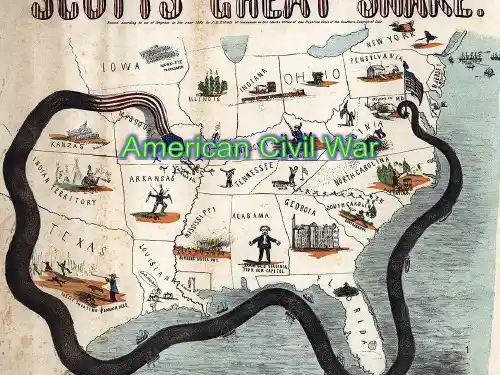
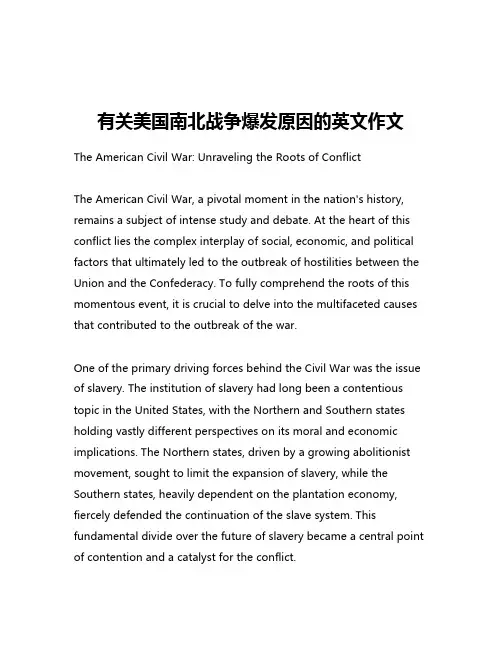
有关美国南北战争爆发原因的英文作文The American Civil War: Unraveling the Roots of ConflictThe American Civil War, a pivotal moment in the nation's history, remains a subject of intense study and debate. At the heart of this conflict lies the complex interplay of social, economic, and political factors that ultimately led to the outbreak of hostilities between the Union and the Confederacy. To fully comprehend the roots of this momentous event, it is crucial to delve into the multifaceted causes that contributed to the outbreak of the war.One of the primary driving forces behind the Civil War was the issue of slavery. The institution of slavery had long been a contentious topic in the United States, with the Northern and Southern states holding vastly different perspectives on its moral and economic implications. The Northern states, driven by a growing abolitionist movement, sought to limit the expansion of slavery, while the Southern states, heavily dependent on the plantation economy, fiercely defended the continuation of the slave system. This fundamental divide over the future of slavery became a central point of contention and a catalyst for the conflict.Closely tied to the issue of slavery was the ongoing debate over the balance of power between the federal government and the individual states. The Southern states, fearing the erosion of their autonomy and the potential for federal intervention in their economic and social structures, increasingly advocated for the doctrine of states' rights. They argued that the Constitution granted the states the authority to nullify federal laws and even secede from the Union if they felt their interests were being threatened. This clash between the centralized federal authority and the states' rights philosophy was a significant factor in the growing tensions that ultimately led to the outbreak of the war.Economic disparities between the North and the South also played a crucial role in the events leading up to the Civil War. The Northern states had undergone a process of industrialization, with a thriving manufacturing sector and a diverse economy. In contrast, the Southern economy remained largely agricultural, relying heavily on the production of cash crops such as cotton, tobacco, and sugar, all of which were heavily dependent on slave labor. This economic divide led to conflicting interests and the perception that the federal government was favoring the industrial interests of the North over the agrarian concerns of the South.Political tensions and the rise of sectionalism, the growing divide between the North and the South, further exacerbated the situation.The election of Abraham Lincoln, a Republican who opposed the expansion of slavery, in 1860 was seen by the Southern states as a threat to their way of life. The Southern states, fearing the potential loss of political influence and the erosion of their economic power, ultimately decided to secede from the Union, triggering the outbreak of the Civil War.It is important to note that the causes of the Civil War were multifaceted and intertwined. The issue of slavery, the debate over states' rights, economic disparities, and the rise of sectionalism all contributed to the growing tensions that ultimately led to the outbreak of the conflict. The complexity of these factors underscores the need for a nuanced understanding of the historical context and the various forces at play in the events leading up to the American Civil War.。
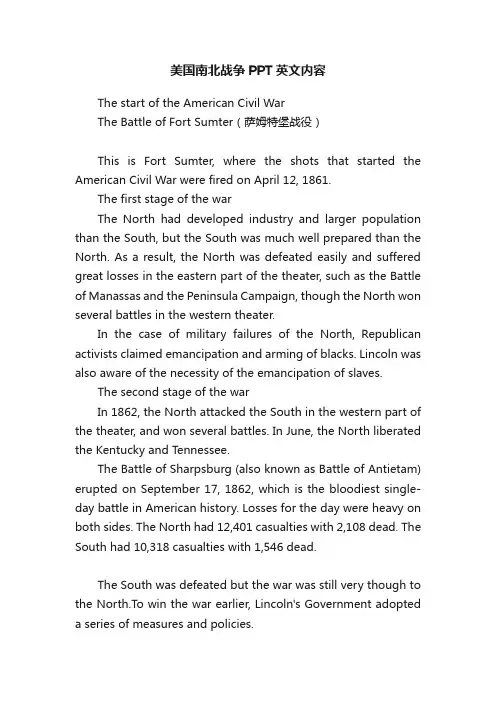
美国南北战争PPT英文内容The start of the American Civil WarThe Battle of Fort Sumter(萨姆特堡战役)This is Fort Sumter, where the shots that started the American Civil War were fired on April 12, 1861.The first stage of the warThe North had developed industry and larger population than the South, but the South was much well prepared than the North. As a result, the North was defeated easily and suffered great losses in the eastern part of the theater, such as the Battle of Manassas and the Peninsula Campaign, though the North won several battles in the western theater.In the case of military failures of the North, Republican activists claimed emancipation and arming of blacks. Lincoln was also aware of the necessity of the emancipation of slaves.The second stage of the warIn 1862, the North attacked the South in the western part of the theater, and won several battles. In June, the North liberated the Kentucky and T ennessee.The Battle of Sharpsburg (also known as Battle of Antietam) erupted on September 17, 1862, which is the bloodiest single-day battle in American history. Losses for the day were heavy on both sides. The North had 12,401 casualties with 2,108 dead. The South had 10,318 casualties with 1,546 dead.The South was defeated but the war was still very though to the North.To win the war earlier, Lincoln's Government adopted a series of measures and policies.Homestead Act was issued in 1862,which helped the North to get solid financial support, and win the war in the end.The Emancipation Proclamation was issued by Lincoln on September 22, 1862, which announced the liberation of slaves and allowed the black people to join the army of the North.This action helped the North to get more supports and attracted more and more black people to flee from and then attack the South.During 1862 and 1863, black people, who mainly fled from the South, were armed to fight against the South.On July 1, 1863, the two sides battled at Gettysburg, and the South was defeated finally. Both of the two sides suffered great losses, but the initiative on the battlefield turned into the hands of North and this battle became the turning point of the Ameriacn Civil War.Almost at the same time, the Confederate defense surrounded by the North since February,1863 at Vicksburg,which was vital to the control the Mississippi River and the railway networks of western America,finally surrendered on July 4. They had eaten up all what they could get, including cats, rats and snakes, before they gave in.In 1864, the North adopt to new strategy and started attacking the South in two directions at the same time. In the eastern part of the theater, wearing down the enemy forces was the main goal. And in the western part of the theater, the North tried to penetrate enemy hinterland and cut off the links of "Confederacy" between the Northeast and the Southwest.In September, the North captured Atlanta and two monthslater the famous "March to the sea" began, the March completely destroyed various military and civilian facilities of the enemy, so that the economies of the South came to a standstill. In the east part of the theater, the North drove the enemy to the rebel "capital" Richmond.In early 1865, the South's plantation economy was just near a crash, because most slaves had fled and the North imposed a naval blockade since 1861, which at last almost cut off the South's trade with Europe. The blockade was the Union Blockade, which was raised by Winfield Scott.Deserters of the South was growing rapidly. What's more, weapons, food and daily necessities were all scarce. Finally on April 9, 1865, the Confedrate army surrounded by the North gave in. The American Civil War came to the end.。
本文部分内容来自网络整理,本司不为其真实性负责,如有异议或侵权请及时联系,本司将立即删除!== 本文为word格式,下载后可方便编辑和修改! ==关于美国南北战争的英语演讲稿篇一:美国内战中英文介绍1.Civil WarThe American Civil War (1861–1865), often referred to simply as The Civil War in the United States, was a civil war fought in the United States of America. In response to the election of Abraham Lincoln as President of the United States, 11 southern slave states declaredtheir secession from the United States and formed the Confederate States of America ("the Confederacy"); the other 25 states supported the federal government ("the Union"). After four years of warfare, mostly within the Southern states, the Confederacy surrendered and slavery was outlawed everywhere in the nation. Issues that led to war were partially resolved in the Reconstruction Era that followed, though others remained uesolved.In the presidential election of 1860, the Republican Party, led by Abraham Lincoln, had campaigned against expanding slavery beyond the states in which it already existed. The Republicans strongly advocated nationalism, and in their 1860 platform they denounced threats of disunion as avowals of treason. After a Republican victory, but before the new administration took office on March 4, 1861, seven cotton states declared their secession and joined to form the Confederate States of America. Both the outgoing administration of President James Buchanan and the incoming administration rejected the legality of secession, considering it rebellion. The other eightslave states rejected calls for secession at this point. No countryin the world recognized the Confederacy.Hostilities began on April 12, 1861, when Confederate forces attacked a U.S. military installation at Fort Sumter in South Carolina.Lincoln responded by calling for a volunteer army from each state to recapture federal property, which led to declarations of secession by four more slave states. Both sides raised armies as the Union seized control of the border states early in the war and established a navalblockade. Land warfare in the East was inconclusive in 1861–62, as the Confederacy beat back Union efforts to capture its capital, Richmond, Virginia, notably during the Peninsular Campaign. In September 1862, the Confederate campaign in Maryland ended in defeat at the Battle of Antietam, which dissuaded the British from intervening.[2] Days after that battle, Lincoln issued the Emancipation Proclamation, which made ending slavery a war goal.[3]In 1863, Confederate general Robert E. Lee's northward advance ended in defeat at the Battle of Gettysburg. To the west, the Union gained control of the Mississippi River after the Battle of Shiloh and Siege of Vicksburg, splitting the Confederacy in two and destroying much of their western army. Due to his western successes, Ulysses S. Grant was given command of the eastern army in 1864, and organized the armies of William Tecumseh Sherman, Philip Sheridan and others to attack the Confederacy from all directions, increasing the North's advantage in manpower. Grant restructured the union army, and put other generals in command of divisions of the army that were to support his push into Virginia. He fought several battles ofattrition against Leethrough the Overland Campaign to seize Richmond, though in the face of fierce resistance he altered his plans and led the Siege of Petersburg which nearly finished off the rest of Lee's army. Meanwhile, Sherman captured Atlanta and marched to the sea, destroying Confederate infrastructure along the way. When the Confederate attempt to defend Petersburg failed, the Confederate army retreated but was pursued and defeated, which resulted in Lee's surrender to Grant at Appomattox Court House on April 9, 1865.The American Civil War was one of the earliest true industrial wars. Railroads, the telegraph, steamships, and mass-produced weapons were employed extensively. The practices of total war, developed by Sherman in Georgia, and of trench warfare around Petersburg foreshadowed World War I in Europe. It remains the deadliest war in American history, resulting in the deaths of 620,000 soldiers and an undetermined number of civilian casualties. Historian John Huddleston estimates the death toll at ten percent of all Northern males 20–45 years old, and 30 percent of all Southern white males aged 18–40.[4] Victory for the North meant the end of the Confederacy and of slavery in the United States, and strengthened the role of the federal government. The social, political, economic and racial issues of the war decisively shaped the reconstruction era that lasted to 1877.美国南北战争(1861-1865),通常被称为在美国南北战争,是一场内战,战斗在美利坚合众国。